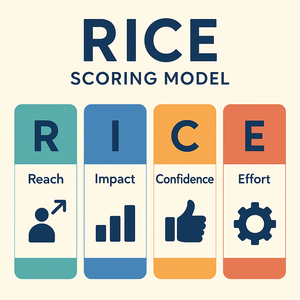RICE Scoring Model

A collaborative prioritization framework where teams apply the RICE scoring model (Reach, Impact, Confidence, Effort) to evaluate and rank ideas, projects, or initiatives.
Goal
Rank a set of initiatives with the RICE scoring model (Reach, Impact, Confidence and Effort) to carefully prioritize and create alignment.
Instructions
- Provide a quick overview of what RICE stands for:
- Reach – How many people will be affected in a given period of time?
- Impact – How much will it move the needle (on a 0.25–3 scale)?
- Confidence – How sure are we about our estimates (expressed as a percentage)?
- Effort – How many “person-weeks” or units of work will it take?
- Explain the scoring formula and that the result is a single number for each item that helps prioritize ideas with a greater degree of accuracy.
RICE Score= Reach × Impact × Confidence / Effort - If working with the RICE model for the first time, provide a brief example of what each part of the RICE scoring model means in the context of your product or team.
Defining Reach in the RICE scoring model Reach is the number of people you expect to reach with your initiative. Ensure you choose a reach metric you can actually measure and ideally have historical data for.
- As with all the items in the RICE model, the key is ensuring that all of the items you're ranking are using the same metric for reach, whether that's number of people reached, number of new customers or other value.
Defining Impact in the RICE scoring model
Define what you expect the initiative to impact: for example, do you expect conversion rates to rise, a reduction in churn or improved feature adoption? Then, give each item a score based on the below values.
- 3 = massive impact
- 2 = high impact
- 1 = medium impact
- .5 = low impact
- .25 = minimal impact
Defining Confidence in the RICE scoring model
In the RICE model, confidence is expression as a percentage:
- 100% = high confidence
- 80% = medium confidence
- 50% = low confidence
- Less than 50% = very low confidence
When considering the confidence score for a specific initiative, keep in mind how you've calculated your potential reach and impact. If your reach calculation is a loose estimate, it would likely flow that your confidence score would be lower too.
Defining Effort in the RICE scoring model
Effort is the amount of work a task will take, most often expressed as people-hours, weeks or months. Where possible, be sure to consult those people involved in doing such work for a more accurate measure here.
When defining each item in RICE, it's worth giving some examples relevant to your group. For example, you might give an example of a recent initiative you would have given 100% confidence or with an impact score of 1. This shared understand is helpful for ensuring alignment later in the process.
Step 2: Present the Items to Prioritize- Share a list of 5–10 initiatives the team needs to prioritize.
- Give a brief description of each so everyone understands the context.
- Groups work together to assign values for Reach, Impact, Confidence, and Effort for each item.
- Invite major stakeholders and those people closest to each task to provide insights that might impact on the Reach, Impact, Confidence and Effort scores.
- Once scores are set, calculate the RICE score for each item. You can use a calculator or a pre-made spreadsheet with a simple formula.
Step 4: Rank items by RICE score
- Rank initiatives by RICE score and present them to the group.
- Final decision maker or team reviews the teams and sets final priority.
- In some cases, the list of items with their RICE scores can be turned into a list of tasks that you'll work on in that order. In others, other dependencies and considerations might mean that tasks move up or down in rank when choosing what to move forward with next. For example, a product redesign might be the highest ranking item in the scoring model, but your design team might not be able to work on it until the next quarter. As such, you might bump another item up the list first.
- Once you've aligned on your final priorities, set next steps which may include adding tasks to your project management tool, assigning task owners and setting a followup progress meeting.
Step 6. Close the RICE scoring session
- Close the prioritization process with a round of reflection from the group.
Attachments
- RICE scoring model image.png
Background
The RICE scoring model and framework was first developed by the product team at Intercom. I've seen it used by many teams, though most often when it comes to prioritizing product initiatives and user-focused improvements.
Author
James Smart is Head of Content at SessionLab. He’s facilitated workshops and designed elearning experiences for places including the University of East Anglia and the National Centre for Writing.
More about author